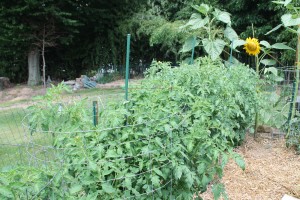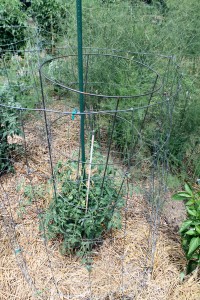Heng’s Tomato Tips
July 20th, 2015
I know a lot of you are struggling with rampant disease on your tomato plants.
This favorite of all back-yard edibles used to be fairly easy to grow, but a pair of fungal diseases (early blight and septoria leaf spot) have made growing a season-surviving tomato a real challenge.
This season’s plentiful rain and warm, humid air has been especially amenable for these diseases.
Those old-fashioned, good-tasting heirloom tomatoes that have come back into vogue lately have a particular rap of being disease-prone.
So how come Heng Lim’s heirloom tomatoes are looking so good?
Heng has been growing tomatoes for 40 years in his Derry Twp. garden, and he leans almost exclusively to heirlooms.
These days, he’s zeroed in on just a few all-time-favorite, best-tasting heirlooms – ‘Red Belgium,’ ‘Yellow Belgium’ and ‘German Yellow,’ to be exact.
Yet those supposed disease-prone heirlooms are looking extremely bushy and virile in his yard. There’s only the slightest trace of yellowing at the very bottom of the plants… not like so many tomatoes that are already yellowing halfway up.
Heng is convinced the difference is doing as much as possible culturally to keep tomatoes naturally healthy and vigorous. His theory is that happy tomatoes fight off and grow through trouble themselves without much in-season hand-holding from the gardener.
Heng doesn’t spray, and he doesn’t even fertilize several times throughout the season as most tomato experts advise.
The game plan must work because Heng’s dozen plants look much healthier than mine.
His approach is similar to what he preached during his career as a cardiologist… it’s a whole lot better to avoid trouble by eating healthy and getting exercise than to try and undo damage later.
Here’s what Heng does in his tomato garden…
* Supply magnificent soil. “I plant my tomatoes like most people plant a tree,” Heng says. “I’ll dig holes that are 18 to 20 inches wide and almost 2 feet deep. Every year, I improve the soil by about 50 percent.”
In the fall, he works in the straw that he uses every season as a mulch over the soil surface – a move that also keeps soil-borne disease spores from splashing up onto new tomato transplants.
But he also works in assorted helpings of compost, composted horse manure, mushroom soil (the manure and straw or sawdust byproduct of commercial mushroom growing) and his favorite brand of bagged mix, Baccto Planting Mix.
With all of the nutrition available from those organic ingredients as they break down, Heng says he’s found there’s no need to add more fertilizer in season.
He says that if you feed the soil, plants will mine what they need as they need it.
* Grow in raised beds. Heng started out with markedly better soil than most people. He has rare sandy loam instead of our more typical clay, shale or builder’s subsoil. But he still built up his vegetable garden higher than grade from the beginning – a depth that’s grown over the years because of the annual soil amendments.
The raised garden gives his plants extraordinary drainage and makes it super-easy for roots to reach far and wide. Extensive roots allows his plants to maximize both the uptake of moisture and nutrients.
His garden soil is fluffier and softer than a Serta mattress. You could sleep on it.
* Big, healthy babies. Like a lot of serious tomato gardeners, Heng starts his own tomato seedlings inside under grow lights. But instead of leaving the seedlings in their original pot or “potting up” once, he moves his plants into three increasingly larger pot sizes.
By the time they’re ready to go in the ground, they’re already 14 to 16 inches tall, bushy and root-dense – much better developed than even the single-plant, 4-inch pots sold in garden centers. And they’re way better developed than little ones sold in 4- or 6-plant cell packs.
* Deep and warm planting. Heng says one mistake many people make is trying to get their tomatoes in the ground too soon.
“Tomatoes are tropicals,” he says. “If you plant them too soon, they’ll languish in the cold weather.”
He waits until mid-May to plant most years. And when he does plant, he buries them almost halfway up the stem.
You can’t do that with most plants – and especially not with trees and shrubs. That’s a fast way to kill those. But tomatoes have the ability to push out roots along buried stems, so instead of croaking, they actually develop a more elaborate root system.
* Give the plants air. Planting too closely is a sure-fire recipe for disease. Crowded foliage doesn’t dry well, and that added leaf moisture fuels the fungi that cause spotting and yellowing.
Heng gives his plants about 3 feet of space apart. He then pinches out some of the excess branching to aid air flow through the plants, and he removes the lowest limbs when he sees disease trying to start its way up.
Part of his air-attack policy is to stake well, too, so plants aren’t lying on the ground or flopping onto one another.
Heng uses a two-cage system – one an inner cage and one an outer cage. He jams a stake into the ground around each tomato and ties a store-bought tomato cage (one of those pyramidal wire cylinders) to it.
Then he uses 10-foot sections of “cow fencing” (stiff wire with wide openings big enough to fit your hand through) to make a wider cylinder around the cage. The tomatoes then grow through the inner cage and then get supported and contained by the outer cage, resulting in tomato “bushes” that are both solidly supported and pickable, thanks to the widely spaced cow fence.
All of that yields Heng huge and tasty fruits that keep coming until frost.
I’ll be really jealous then because the last few years, my tomatoes got diseased enough that I was done with fresh picking by September.
It’s a long time between October and June to go without a decent tomato…
For more on growing tomatoes, check out the piece I wrote on the “Troubles with Tomatoes” and the Pennlive post I did on “Tomatoes Yellowing and Dying from the Ground Up.”
For more on heirloom tomatoes, read the garden column I wrote on “How to Grow Tomatoes That Will Move You to Tears.”









